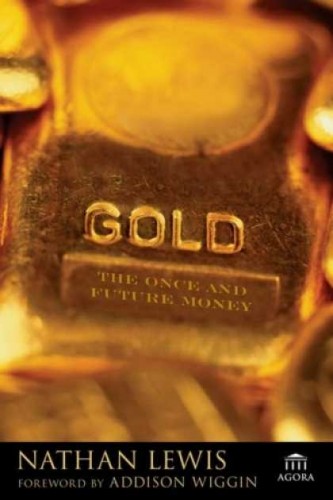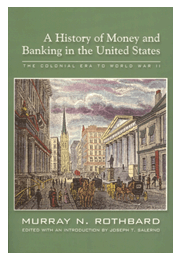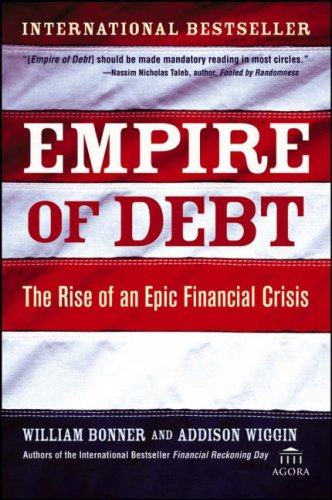
Gold: The Once and Future Money
By Nathan Lewis
John Wiley & Sons 2007
432 pages. $27.95
The title of this book is, of course, a play on White’s wonderful book The Once and Future King, wherein a perfect kingdom – called Camelot – is slowly but surely destroyed by frail and imperfect human beings. And according to the author of Gold – Nathan Lewis – the gold standard is the foundation of any economy desirous of being a Camelot. In that sense, then, Gold is a plea for a return to sanity – the gold standard.
The book is presented in three parts. Part One takes a look at the history of money, what it is and how it works. Part Two examines the history of America’s money, from Colonial silver through the 1930s and into the Reagan administration and the Greenspan years. The third part of Gold discusses recent currency crises around the world, including Japan, the Asian crisis of the 1990s, Russia, China, Mexico and Yugoslavia.
Essentially, Gold is an economic interpretation of history.
The author starts off with an entertaining overview of the idea of barter. The reader learns farm tools, coins, shells, beaded belts, cigarettes and chocolate have functioned as money at one time or another. And although convenient, barter is an inefficient economic tool, because it is too arbitrary. This arbitrariness is not conducive to productivity or prosperity. Which means that throughout history mankind has gravitated to more stable systems of money. According to the author, currency “pegged to the gold standard” is the most stable monetary system.
Lewis then takes the reader on an excursion through the history of hard money and soft money. He notes that hard money has been around since 700 BC, when the Lydians began minting metallic coins. The Roman Empire had a stock exchange. And China was the first nation to use paper money. Holland, in its quest for economic stability, fixed a rate of exchange based on gold coins. And, interestingly, Britain was the first major player to establish a gold standard. By 1900, most nations in the world – except China – followed suit and went on a gold standard.
World War I and World War II disrupted everything, causing inflation, deflation, recessions, and devaluations. Then, in 1971, Nixon did away with the gold standard. And ever since then, the global economy has revolved around fiat currency.
In Lewis’ opinion, this was the beginning of the end. For inflation became the order of the day. Lewis refers to the present system of fiat currency as “laughably simplistic.” He compares the fall of Rome, the Weimar Republic and the U.S., demonstrating how inflation not only destroys whole economies, but also promotes immorality. Inflation and self-destruction go hand in hand.
From there, Lewis moves on to inspect the ins and outs of central banking. He notes that the Federal Reserve System was set up for the sole purpose of mitigating economic crises. Currency manipulation was not part of the Fed’s original design. In other words, the Fed has annexed powers to itself. Thus, rather than being part of the answer to economic crises, the Fed has become part of the problem leading to such crises.
One of the most fascinating portions of Gold is Lewis’ discussion of the Reagan years, when Reagan proposed his Rosy Scenario. Reagan believed a good economic policy was one that would “result in a better economy, not a worse one.” Political circumstances did not allow Reagan to do what he desired. However, because of lower income taxes, the economy grew like gangbusters. This section of the book is both enlightening and entertaining, as Lewis forges his words with aplomb and insight.
The Greenspan years provides a lot of food for thought, especially since Lewis points out that it was Clinton and not Bush that pumped new life into the U.S. economy. Clinton did so by imitating Reagan’s economic plan.
Lewis proceeds to talk about the Asian Crisis of the 1990s. His conclusion is simple. Due to a rising King Dollar and no gold standard, most of Asia, along with Brazil, Russia and Argentina, suffered economic disasters. Nevertheless, apparently no one discerned the real cause of the economic malaise. Fiat currency still holds sway.
In the section on Russia, Lewis shows how the fall of the Soviet Union can be traced to fiat currency. Because of paper money, Russia’s economy became nothing more or less than “a vast mafia.” When the Russian economy finally collapsed under its own profiteering, so too did the Soviet Union. The whole thing came tumbling down.
The last chapter of Gold talks about a return to hard currency. Lewis believes “the era of soft money is slowly coming to an end.” In his opinion, the global economy has no alternative. It must go back to hard money. Therefore, he proposes a new gold standard, which includes “a provision for convertibility.” He explains that convertibility keeps governments honest.
His proposal includes a trading band of 2%, and a central banking system that exists for only one reason: “the prevention of liquidity-shortage crises.” This means the Fed would not bail-out “insolvent institutions with long-term financial difficulties.” In other words, Lewis is proposing what he calls “a fully modernized version of the classical gold standard.” As he writes, “It works. Very well, in fact.”
He admits the most difficult part of such a transition would be the establishment of dollar/gold parity. In his estimation, the “correct parity is the economy’s ‘center of gravity,’ the point that balances the forces of inflation and deflation and the interests of creditors and debtors.” If done carefully, Lewis believes such a transition would “be seamless.”
The greatest obstacle to a return to the gold standard is the central banks, because they have the most to lose. Their power and influence would be lost overnight. As Lewis points out, “They are large bureaucracies, and no bureaucracies encourage their own demise.”
Gold is an important book. It has much to offer. It is well-written and easy to read. Its only flaw might be the author’s optimism. One doubts that a return to a gold standard – as desirable as it may be – is as inevitable as set forth in the book.
![]() On the Read-O-Meter, which ranges from 1 star (deplorable) to 5 stars (noteworthy), Gold: The Once and Future Money commands 5 stars.
On the Read-O-Meter, which ranges from 1 star (deplorable) to 5 stars (noteworthy), Gold: The Once and Future Money commands 5 stars.



